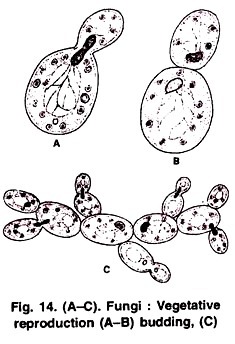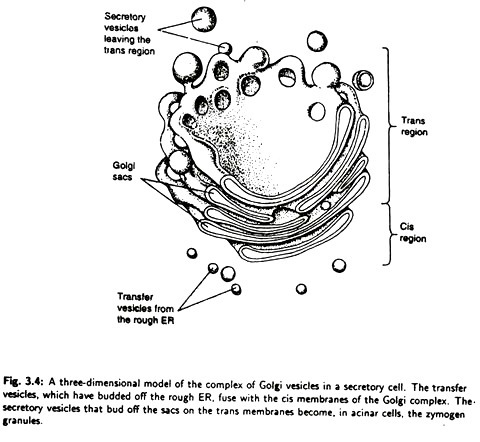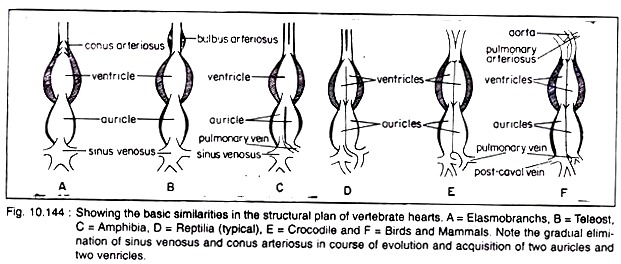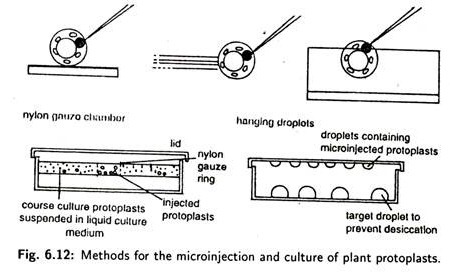Mixing and agitation are used for blending of liquid. Mixing, actually, describes more precisely an operation in which two or more materials are intermingled to attain a desired degree of uniformity.
Agitation on the other hand describes those operations by which turbulence in a liquid is promoted. Mixing and agitation find wide applications in microbial engineering processes.
Depending on the nature of fluid and the mixing vessel different types of impellers are used to achieve the required degree of blending (Fig. 5.6).
Impeller Types:
Propellers:
The marine propeller is a relatively small, high speed impeller widely used in low viscosity liquid systems. It has a high rate of flow displacement and generates strong currents in an axial direction. Speed of rotation will vary from 400 rpm for large diameter propellers to 1750 rpm for those having smaller diameters.
Turbines:
A flat blade turbine (FBT) impeller is widely used in many submerged microbial/ biochemical reactions. A FBT consists of several straight blades mounted vertically on a flat plate. The blades of some turbine impellers are curved or tilted from the vertical. Fish fin impeller is another example of this type. In this type of impellers rotation is at moderate speeds and fluid flow is generated in a radial and tangential directions.
Paddles:
Paddle impellers range in design from a single, flat paddle on a vertical shaft to a battery of multi-blade flocculates mounted on a long, horizontal shaft. These impellers run at a slow to moderate speed (2 to 150 rpm) and are used to mix high viscosity liquids. Radial and tangential currents are generated during rotation of paddles. In selection in most cases it is basically the same as that of a turbine with large D/D, ratio—for such applications as blending of viscous non-Newtonian fluids.
Hydrofoil Impellers:
These are a class of axial flow impellers with low power numbers than pitched blade turbines. They have been designed to produce high flow with low turbulence.
Impeller Selection:
Each of the impellers discussed above has its own characteristics and suited for particular services. Although in some cases two impeller types may perform equally good, but, in general, a given service will be satisfied best by only one. In microbial reaction system impeller shear forces and conversion of impeller power input into heat are important factors.
For filamentous and mycelial systems high impeller shear stress may cause disruption of the cells leading to less product yield. Also, all the power input into the biological fluids where the microbial cell size increases, is eventually converted into heat at the rate nearly 2545 BTU/hr/HP. It needs adequate control of temperature in the biological systems which are thermo-sensitive.
Therefore heat transfer phenomenon has a great significance to regulate microbial reactions and accordingly impeller type should be selected. Types include flat blade turbine (FBT), pitched blade and curved blade. In mycetial fermentations fish fin impellers have been found to be suitable as it suited in many other biological systems.
As the KL term in KLa is relatively insensitive to agitation intensity, the area per unit volume is the primary cause of change of KLa. In effect, a better dispersion of the gas to finer bubbles causes an improvement in the measured KLa. One of the important features of agitator drive selection procedure considered for various levels of gas dispersion, superficial gas velocity, and equivalent volume—enables the selection of commercially available turbine agitators. Turbine agitators are identified in terms of prime-mover power, HP and shaft speed, N.
Tables are available in condensed versions listing turbine agitators capable of producing gas dispersion levels ranging from 1 to 10 in equivalent—volume sizes ranging from 750 to 75,000 gal for gas velocities of 0.07 and 0.20 ft/sec.
At higher levels of gas dispersion, agitator selections become independent of superficial gas velocity and are a function only of equivalent volume, defined as Veq = SgV where Sg is specific gravity of the liquid and V is volume of the un-gassed liquid. At lower levels, where proximity to flooding affects the degree of gas dispersion, the selections are functions of both superficial gas velocity and Veq.
High Shear Impellers:
High shear agitation includes applications generally known as emulsification, dispersion or homogenization. It is the relatively narrow processing area lying between the agitation intensity of conventional impellers at high P/V and the shear forces generated by homogenizers or colloid mills. Proper selection of impellers for this service involves maximizing the impeller head N2Di2 and minimizing the flow ND23. This is done by using a relatively small Di/Dt ratio, a high speed and small blade area. For a quantitative evaluation of the performance of various impeller types a paper by Fondy and Bates (AHChE J, 9,338, 1963) provides good reference.
Based on predominant flow pattern impellers are grouped under three heads as below (Fig. 5.8)
Impeller Design Factors:
In submerged microbial reactions FBT is widely used. In designing an impeller for a stirred tank bioreactor its geometry should bear proper dimensional ratio with tank geometry. Conventional ratios of the dimensions in a FBT are as below.
Power Theory:
Power theory has been discussed for many years. Impeller power data available are mostly based on a simplification of the full correlation. Assuming full geometric similarity of impeller system and considering gravitational effects, the relationship is
Np = K (NRe)a (NFr)b
Where Np and NRe are power and Reynolds numbers respectively and are dimensionless. Here NFr is also a dimensionless number, known as Froude number and a and b are exponents where as K is a constant. Gravitational force represented by NFr is effective only when flow is turbulent and vortex is formed around the axis of the impeller. Characteristic impeller power curves in the figure 5.9 is the typical representation of the simplified relations.
Power Input:
The productivity of most aerobic fermentations depends greatly on the aeration capacity and blending efficiency in the liquid. Aeration capacity and blending efficiency in turn are related to energy consumption. Power input defined as the rate of doing work or the rate of flow of energy provides a measure of energy consumption. In SI unit’s power is measured in watts (W). The traditional units of power is hp (550 ft 1bf/s) which is related to watt as 1hp = 745.7 W.
Electrical energy is determined as the quantity of power supplied over a period of time (t). Thus energy = Pt with the units of KWh [Electrical power P = current flow (A) x electrical potential (v)]. The power input is conventionally expressed as hp/100 gal which in SI units is equivalent to 1.64 KW/m3. It is difficult to correlate the impeller power input in gassed and non- gassed system to operating and geometric parameters of the bioreactor by analytical approach. When the analytical approach does not yield a solution, the technique of dimensional analysis may be used in the rational treatment of a problem.




